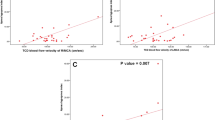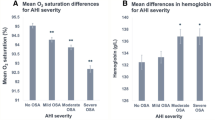Abstract
Purpose
Pulse oximetry plays an essential role in the diagnosis of sleep apnea syndrome. We discovered two novel hemoglobin anomalies, Hb Bonn and Hb Venusberg, which initially resulted in avoidable sleep disorder examinations and therapeutic consequences due to their low oxygen saturation levels as measured by pulse oximetry.
Methods
Hematological as well as clinical chemical diagnosis was carried out. Hemoglobin anomalies were detected through electrophoresis, chromatography, spectrophotometry, and pulse oximetry as well as hemoglobin gene sequencing.
Results
Hb Bonn is a novel hemoglobin mutation of the proximal α1 globin with an additional absorption maximum of the oxyhemoglobin at 668 nm. This results in pulse oximetry measurements of false low oxygen saturation due to incorrect calculations at the pulse oximetry measuring point 660 m. Hb Venusberg is a novel oxygen-affine hemoglobin mutation of the β-globin which is electrophoretically silent. Clinical symptoms include intermittent low oxygen saturation levels, cyanosis of lips and nail beds, and limited physical resistance to stress.
Conclusions
Hemoglobin anomalies, such as Hb Bonn and Hb Venusberg, should be included in differential diagnosis as potential causes of low oxygen saturation especially in case of nonspecific or conflicting findings.



Similar content being viewed by others
References
Oeverland B, Skatvedt O, Kvaerner KJ, Akre H (2002) Pulseoximetry: sufficient to diagnose severe sleep apnea. Sleep Med 3:133–138
Zamarrón C, Hornero R, del Campo F, Abásolo D, Alvarez D (2006) Heart rate regularity analysis obtained from pulse oximetric recordings in the diagnosis of obstructive sleep apnea. Sleep Breath 10:83–89
Schnapp LM, Cohen NH (1990) Pulse oximetry. Uses and abuses. Chest;98:1244-1250
Braghiroli A, Álvarez-Sala R (2002) Potential sleep disordered breathing and COPD. Sleep Breath 6:1–2
Zur B, Hornung A, Breuer B, Doll U, Bernhardt C, Ludwig M, Stoffel-Wagner B (2008) A novel hemoglobin, Bonn, causes falsely decreased oxygen saturation measurements in pulse oximetry. Clin Chem 54:594–596
Zur B, Mayer-Hubner B, Ludwig M, Stoffel-Wagner BA (2012) 14-year-old boy with chronic cyanosis, mild anemia, and limited physical resistance to stress. Clin Chem 58(2):332–335
Nigro CA, Aimaretti S, Gonzalez S, Rhodius E (2009) Validation of the WristOx 3100TM oximeter for the diagnosis of sleep apnea/hypopnea syndrome. Sleep Breath 13:127–136
Bowes WA, Corke BC, Hulka J (1989) Pulse oximetry: a review of the theory, accuracy, and clinical applications. Obstet Gynecol 74:541
Cecil WT, Thorpe KJ, Fibuch EE, Tohy GF (1988) A clinical evaluation of the accuracy of the Nellcor N-100 an Ohmeda 3700 pulse oximeters. J Clin Monit 4:31
Mendelson Y (1992) Pulse oximetry: theory and applications for noninvasive monitoring. Clin Chem 38(9):1601–1607
Katoh R, Miyake T, Arai T (1989) Unexpectedly low pulse oximeter readings in a boy with unstable hemoglobin Köln. Anesthesiology 70:112
Hohl RJ, Sherburne AR, Feeley JE, Huisman THJ, Burns CP (1998) Low pulse oximeter-measured hemoglobin oxygen saturations with hemoglobin Cheverly. Am J Hematol 59:181–184
Kuji A, Satoh Y, Kikuchi K, Satoh K, Joh S (2001) The anesthetic management of a patient with haemoglobin M(Iwate). Anesth Analg 93:1192–1193
Sarikonda KV, Ribeiro RS, Herrick JL, Hoyer JD (2009) Hemoglobin Lansing: a novel haemoglobin variant causing falsely decreased oxygen saturation by pulse oximetry. Am J Hematol 84:541
Hayashi A, Shimizu A, Yamamura Y, Watari H (1966) Hemoglobins M: identification of Iwate, Boston, and Saskatoon variants. Science 152:207–208
Zijlstra WG, Buursma A, der Rost WP Meeuwsen-van (1991) Absorption spectra of human fetal and adult oxyhemoglobin, de-oxyhemoglobin, carboxyhemoglobin, and methemoglobin. Clin Chem 37(9):1633–1638
So CC, Chan AY, Chow EY, Lin SY, Yip SF, Szeto SC, Chan LC (2010) Haemoglobin Bonn in a Chinese family as cause of spurious hypoxaemia measured by pulse oximetry. J Clin Pathol 63:947–949
Rosa J, Labie D, Wajcman H, Boigne JM, Cabannes R, Bierme R, Ruffie J (1996) Haemoglobin I Toulouse: β-66 (E 10) Lys→Glu: a new abnormal haemoglobin with a mutation localized on the E 10 prophyrin surrounding zone. Nature 223:190–196
Kleihauer E (1996) Anomale Hämoglobine und Thalassämiesyndrome: Grundlagen und Klinik. ecomed Verlagsgesellschaft;180-183
Morita K, Fukuzawa J, Onodera S, Kawamura Y, Sasaki N, Fujisawa K, Ohba Y, Miyaji T, Hayashi Y, Yamazaki N (1992) Hemoglobin Kansas found in a patient with polycythemia. Ann Hematol 65:229–231
Nagel RL, Lynfield J, Johnson J, Landau L, Bookchin RM, Harris MB (1976) Hemoglobin Beth Israel—a mutant causing clinically apparent cyanosis. N Engl J Med 295:125–130
Poyart C, Schaad O, Kister J, Galacteros F, Edelstein SJ, Blouquit Y, Arous N (1990) Hemoglobin Saint Mande [beta 102 (G4) Asn-Tyr]. Functional studies and structural modelling reveal an altered T state. Eur J Biochem 194:343–348
Huehns ER, Hecht F, Yoshida A, Stamatoyannopoulos G, Hartmann J, Motulsky AG (1970) Hemoglobin-Seattle (agr2beta276 Glu): an unstable hemoglobin causing hemolytic anemia. Blood 36:209–218
Imamura T, Fujita S, Ohta Y, Hanada M, Yanase T (1969) Hemoglobin Yoshizuka (G10(1008)β asparagine–aspatic acid): a new variant with a reduced oxygen affinity from a Japanese family. J Clin Invest 48:2341–2348
Starkey CR, Davies L, Hoyer JD, Wilson CS, Winter SS (2006) Clinical manifestations of hemoglobin Chico at high altitude. J Pediatr Hematol Oncol 28:760–762
Luo HY, Irving I, Prior J, Lim E, Eung SH, Skelton TP, Erber WN, Steinberg MH, Chui DHK (2004) Hemoglobin Titusville, a low oxygen affinity variant hemoglobin, in a family of northern European background. Am J Hematol 77:384–386
Acknowledgments
For excellent technical assistance, we express our gratitude to Mrs. M. Schmidt.
Conflict of interest
The authors declare that they have no conflict of interest.
Author information
Authors and Affiliations
Corresponding author
Rights and permissions
About this article
Cite this article
Zur, B., Ludwig, M. & Stoffel-Wagner, B. Case–control studies of novel hemoglobin anomalies as differential diagnosis in sleep apnea syndrome. Sleep Breath 17, 557–563 (2013). https://doi.org/10.1007/s11325-012-0720-4
Received:
Revised:
Accepted:
Published:
Issue Date:
DOI: https://doi.org/10.1007/s11325-012-0720-4




